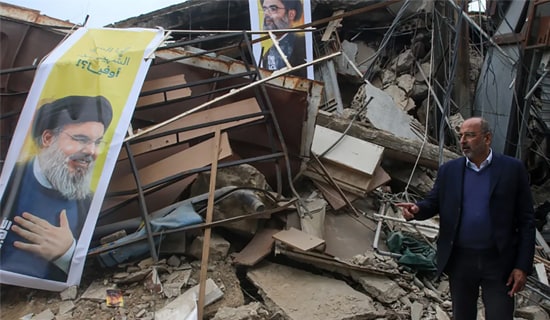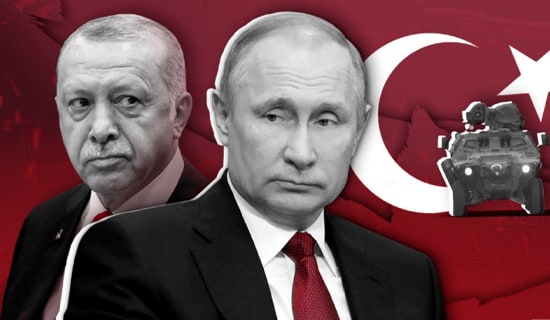Introduction
Since the outbreak in 2011 of the Syria war between the Bashar Al-Assad regime and its domestic and foreign opponents, Iran has acted to consolidate its presence in Syria and tighten its grip on the country, on every level. For Iran, the activity in Syria is not only a means to shore up the Assad regime, but It is also part of exporting Iran's 1979 Islamic Revolution. This is a major goal of the Iranian regime, which seeks to expand the Shi'ite-Iranian hegemony in the Islamic world at the expense of the Sunni hegemony.[1]
Iran has entrenched itself militarily in Syria by deploying high-ranking commanders of its Islamic Revolutionary Guards Corps (IRGC) in the country, as well as multiple Shi'ite militias, including Hizbullah, and by establishing military bases in many areas in order to fight the enemies of the Assad regime. Iran's military presence is especially heavy in the south of the country,[2] and since the outbreak of the Gaza war in late 2023, there have been concerns that Iran may use this strategic region to open up another front against Israel and also to operate against Jordan.[3] In addition, Iran's growing influence in Syria enables it to intervene in the Assad regime's decisions and policies, both foreign and domestic, and even in the makeup Syria's security apparatuses, some of which are loyal to Iran.[4]
In the recent years, Iran has also tightened its economic grip on Syria, by assuming control of lands and facilities in the country. [5] This is one of the Syrian regime's ways of repaying its debt to Iran,[6] which reportedly amounts to some $50 bn.[7]
At the same time, Iran is promoting the Shi'ization and Iranization of Syria by deepening its social, educational, cultural and religious influence in the country with the active support of the Syrian regime.[8] It should be noted that, although the majority of Syrians are Sunni, the Assad family, which has ruled Syria since the 1970s, belongs to the Alawite sect, an ethno-religious group that many Muslim scholars and many Shi'ites used to regard as heretical. In 1973, Moussa Al-Sadr, the leader of the Shi'ites in Lebanon, recognized the Alawites as a sect of Shi'ite Islam,[9] which facilitated an alliance between the Syrian Alawites and Shi'ite elements in Iran. Bashar Al-Assad regards the Iranization and Shi'ization of Syria, which has gained momentum since the outbreak of the war in 2011, as a way to gain strength vis-à-vis his opponents in the country, most of whom are Sunni.[10]
This Iran-led process of Iranization and Shi'ization focuses on the younger generation of Syrians, especially among the Sunni population, and includes the introduction of Iranian-Shi'ite materials in schools and kindergartens and the opening of Iranian universities in Syria. In addition, Iranian culture centers operate in several parts of the country, and hold activities to promote Iran and its culture among Syrians. According to elements in the Syrian opposition, these centers are also meant to help recruit Syrians to join the Iran-backed militias. To encourage participation in their activities, the centers offer participants payment, food and other aid, exploiting the dire conditions in which many Syrians live.
Moreover, with the consent of the Syrian regime, Iran is changing the demography of certain parts of the country by replacing their original residents with members of the Shi'ite militias and their families, many of whom are not even Syrian citizens.
Through this multi-pronged approach, Iran has managed to consolidate its grip on Syria to such an extent that any attempt, Israeli, Arab or international, to drive a wedge between it and the Syrian regime seems futile, and is likely to remain so even if the Iranian and Shi'ite military forces withdraw from Syria.[11]
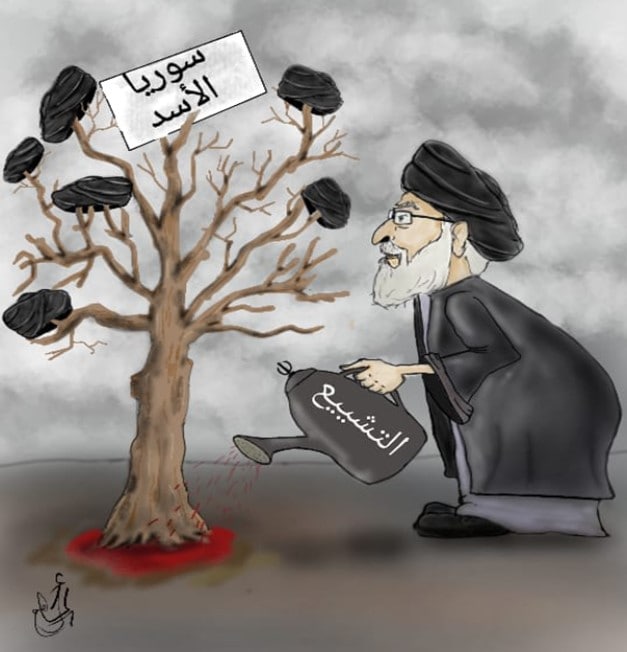
Iran cultivates "Shi'ization" in "Assad's Syria" (Source: Twitter.com/thiqanewsagency, April 27, 2022)
This report reviews the process of Iranization and Shi'ization promoted by Iran in Syria.
Increasing Iranian Infiltration Of Syria's Education System, From Kindergarten To University
A prominent aspect of the Iranization and Shi'ization of Syria concerns the domain of education. Iran engages in extensive educational activity in Syria aimed at spreading its culture among Syrian children and young people. This activity takes place at all levels, from kindergarten to university, and in formal educational frameworks as well as informal ones such as youth movements. Much of the activity is carried out by Iranian organizations that promote the culture and religion of the Ayatollah regime, chief of them the Iranian culture centers, whose directors are Iranian, often high-ranking officers of the IRGC.
In January 2020 Iran and the Syrian regime signed a comprehensive agreement in the domain of education, which, according to some reports, included changes to the Syrian school curricula, the introduction of books produced in Iran, the teaching of Farsi as a second language in Syrian high schools and the establishment of an Iranian pedagogical center.[12] Furthermore, since 2015 six branches of Iranian universities have been opened in Syria, and negotiations to open another, a branch of the Public University of Tehran, are currently underway, according to an announcement by the university's president, Mohammad Moghimi, in December 2023.[13] In addition, Iran grants scholarships to Syrian students in Syrian and Iranian academies and takes part in training teachers for Syrian schools.[14]
The Orient News website, affiliated with the Syrian opposition, reports that since the beginning of the current schoolyear there has been a notable increase in the activity of the Iranian culture centers in the regime-controlled parts of the Deir Al-Zor governorate. As part of this activity, the centers renovated and staffed several schools in order to increase the Iranian and Shi'ite influence in the area. The website states that at least 10 state schools in Deir Al-Zor have been placed under the oversight of the IRGC, that the Iranian culture centers oversee their curricula and that Farsi has been introduced as a mandatory subject in these schools, alongside Arabic.[15]
The Iranian educational activity focuses mainly on children. The culture centers and other organizations operate many Shi'ite kindergartens in which children are taught "the correct tenets of Islam."[16] Many of these kindergartens are free; moreover, children who enroll receive free backpacks, writing materials and other gifts.
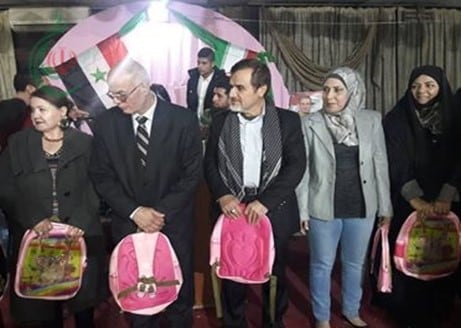
Iranian culture center in Deir Al-Zor hands out free backpacks for children (Source: Iranalyoum.com, January 4, 2019)
The Iranian educational activity in Syria also takes the form of culture events held at Syrian state universities. For example, in the last few years the culture department of the Iranian embassy in Syria, in collaboration with the Farsi Language department at Damascus University, has held events to mark Yalda Night, an ancient Persian winter solstice celebration. The events were attended by the Iranian ambassador to Syria.[17]
In the domain of informal education, there is direct cooperation between Syria's ruling Ba'th party and Iran. In June 2023 the Iranian embassy's culture department signed a memorandum of understandings with the party's youth organization, the Revolutionary Youth Union, on holding culture activities and educational courses for children in both countries.[18] According to the opposition website Euphrates Eye, Somar Zaher, the chairman of the Revolutionary Youth Union, is an Iranian agent whose role is promote Iranian culture and religion among Syrian children, and that the Iranian embassy's culture department recommended him for this job after he excelled at his previous role as the head of the Revolutionary Youth Union in Deir Al-Zor Governorate in 2018-2021.[19] In December 2023, a delegation of the Revolutionary Youth Union visited Iran to deepen the cooperation with Iranian schools and student organizations.[20]
Propagating Shi'ite And Iranian Ideology In Syria, Targeting Mainly Disadvantaged Sectors
The organizations that spread the Iranian and Shi'ite ideology in Syria, which operate in various parts of the country but especially in the Damascus, Rif Dimashq and Deir Al-Zor governorates, exploit the dire circumstances of many Syrians and encourage participation in their activities by offering gifts, food, and financial and other aid. In one case it was even reported that an Iranian organization in the city of Al-Mayadin in the Deir Al-Zor governorate had appropriated aid provided by international organizations and distributed it to students in order to gain their support.[21]
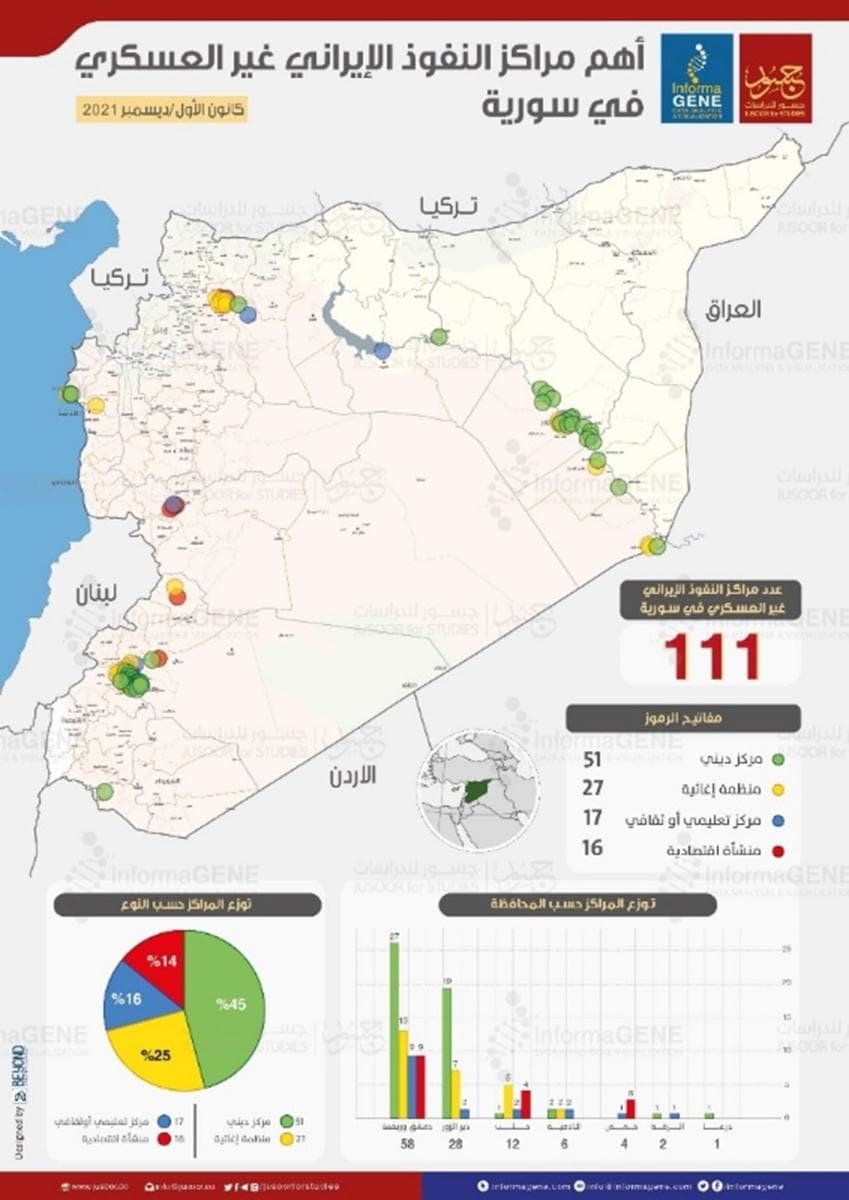
Centers of Iranian non-military influence in Syria in late 2021 (Source: Josoor.com, December 1, 2021)
The Iranian culture centers, which, as stated, are usually headed by senior officers of the IRGC, offer many free and subsidized courses, especially in the Farsi language, as well as activities for children and teens, including trips to Shi'ite sites around the country.[22] They also fund the renovation of civilian infrastructures like hospitals, mosques, schools, kindergartens and the like in order to gain support for Iran among the populace.[23] Representatives from the culture centers spread Iranian propaganda in parks, markets and other public places frequented by families. They hand out presents and candy to children, as well as leaflets advertising the center activities. They also show short films stressing that the Iranian militias are the ones that liberated Syria from the terrorists, and that these militias will also liberate Palestine when today's children join them.[24] The children's activities held by the centers are often centered around the Iranian regime, as exemplified by a quiz held in July 2023 in Deir Al-Zor which included questions about senior figures of this regime, such as IRGC Qods Force commander Qassem Soleimani, who was killed by the U.S. in 2020, or the founder of the Iranian regime, Ayatollah Ruhollah Khomeini.[25]
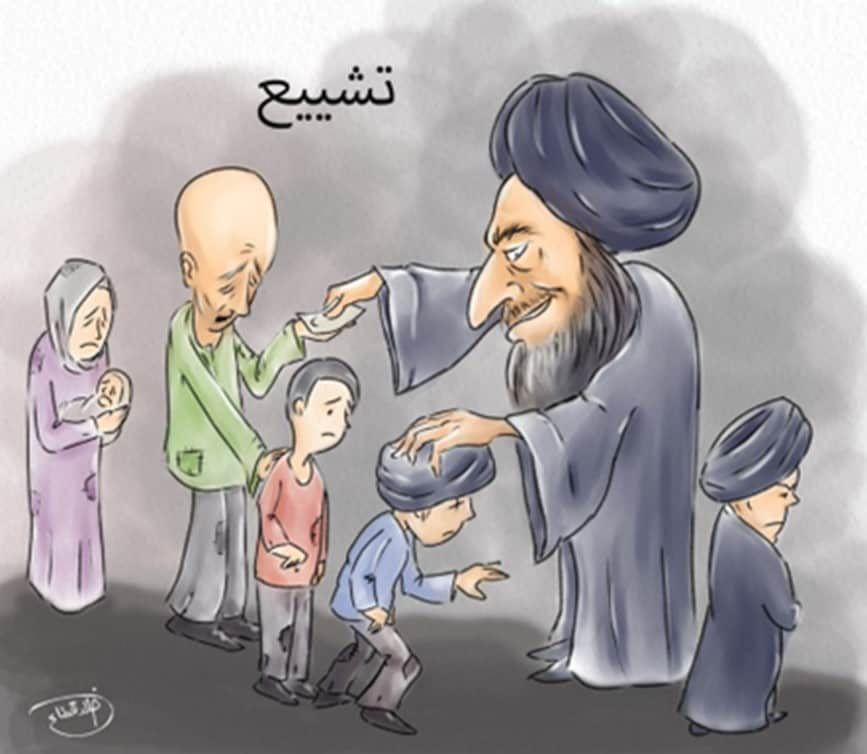
"Shi'ization" (Source: Twitter.com/thiqanewsagency, March 30, 2022)
Sports activities are another vehicle for deepening the Iranian influence among children. According to a February 2022 report on the Orient News website, pro-Iranian elements took over the Al-Fotuwa football club in Deir Al-Zor and promised children admission to its youth team if they attended Iranian and Shi'ite activities in the city.[26] On December 2023, the Ba'th party branch in Deir Al-Zor reportedly made an agreement with the Iranian culture center in the city, under which the center would support the party branch financially, and the party, in return, would recruit local youth for a new sports team at the center that would play in memory of Qassem Soleimani.[27] In January this year, the Iranian culture center in Deir Al-Zor opened sports fields in the city for the free use of the public.[28]
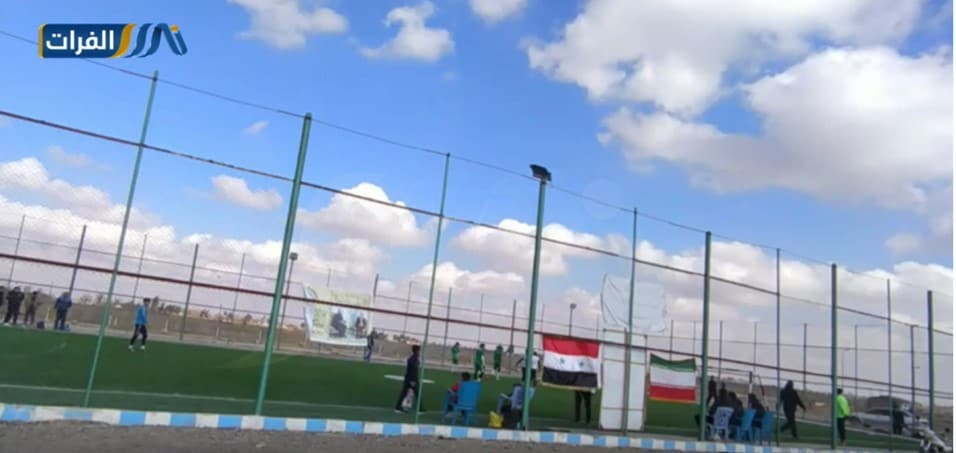
Sports activities for children organized by the Iranian culture center in Deir Al-Zor (Source: Furat-sy.com, January 31, 2024)
Syrian opposition websites explain that the ultimate goal of the Iranian culture centers, especially those in Deir Al-Zor, is to recruit young people for the Iran-backed militias fighting in Syria.[29] Indeed, there are elements that offer military courses for Syrian youths. In December 2023, the Syrian Observatory for Human Rights reported that Hizbullah had held a military training course for teens aged 12-18 in Al-Mayadin in the Deir Al-Zor governorate.[30]
Converting Sunni Mosques To Shi'ite Ones; Spreading Shi'ite Islam
The Iranian effort to change the character of Syria, which is a Sunni-majority country, are also manifest in the conversion of Sunni religious facilities to Shi'ite ones. As part of this, many Sunni mosques have been converted to Shi'ite religious centers (Husayniyyas), and many mosques have been renamed after Iranian and Shi'ite heroes. In February 2022, for example, it was reported that the Sunni Hawbar mosque, in a village by the same name in the Aleppo area, had been renamed the Sayyidna Al-Hussein mosque, after Hussein bin Ali bin Abi Talib, whom the Shi'ites regard as the rightful heir of the Prophet Muhammad.[31] Similarly, in May 2024 it was reported that the Iranians had changed the name of the Sunni Sa'd bin Abi Waqqas mosque, in the town of Talbiseh near Homs, to the Imam Al-Hussein mosque.[32] Moreover, it has been reported more than once that that Iranian organizations agreed to fund the renovation of mosques damaged in the war only on condition of renaming them.[33]

The Al-Batin mosque in the town of Al-Ghubra in the Deir Al-Zor governorate, which has been converted into a Husayniyya, decorated with portraits of Qassem Soleimani and other IRGC commanders (Source: Facebook.com/hacinim, May 3, 2021)
In the city of Deir Al-Zor, where the Iranian influence is strong, the Iranian culture center reportedly appoints mosque personnel and sends preachers and imams for religious courses at the Office of the Cultural Attache in Damascus. These imams and preachers are trained to encourage the locals to embrace Shi'ite Islam in return for food or financial aid.[34] Recently it was also reported that the Iranian culture center has begun dictating the content of mosque sermons.[35] It should be mentioned that similar Iranian activity takes place in Alawite-majority areas of Syria, although their residents have often opposed it.[36]
The Iranian Al-Zahra Association, established in October 2018 by Abu Al-Fadl Al-Tabatabai, the former representative of Iran's Supreme Leader in Syria,[37] operates in the Daraa governorate in southern Syria and has close ties with Syria's Endowments Ministry there. According to the opposition website Tajammu Ahrar Horan, which reports on events in southern Syria, the Endowments Ministry enrolls local mosque preachers in religion and culture courses organized by the Iranian embassy's culture department, which train the preachers to spread Shi'ite Islam in the governorate.[38]
In addition, Iranian religious delegations visit different parts of Syria with the aim of spreading the Shi'ite faith among the locals. In the countryside east of Aleppo, for instance, Iranian clerics have intensely promoted the Shi'a among tribal leaders, realizing that if the leader converts, the members of his tribe are more likely to follow suit.[39] One local chief that has converted is Ahmad Al-Khalaf Al-Faraj, of the Abu Hassan tribe, who, according to a Syrian opposition website, is paid by Hizbullah to spread Shi'ite Islam.[40]
The Shi'ization of Syria also includes the spurious attribution of Shi'ite history to sites in the country. For example, it was reported that the Iran-backed militias claimed that some old tombs in Deir Al-Zor are the burial sites of soldiers from the army of Ali bin Abi Talib, thereby turning them into a pilgrimage site and a hub for Shi'ite proselytizing in the area.[41]
Changing The Demography Of Parts Of Syria In Shi'ites' Favor, With The Consent Of Regime
In addition to the abovementioned efforts of Iranization and Shi'ization, Iran is also working to take over large parts of Syria and turn them into areas with a Shi'ite majority. In the last few years, opposition websites have frequently reported that operatives of the Iran-backed militias are buying land and property, directly or through Syrian real estate agents, especially in the Rif Dimashq and Damascus governorates in the center of the country, and in northeastern Syria. The focus on these regions is not incidental. Rif Dimashq is close to the border with Lebanon and is therefore crucial to maintaining Hizbullah's supply lines. This governorate also includes the Damascus international airport and the major IRGC headquarters adjacent to it,[42] and Damascus is home to important Shi'ite religious sites. As for the northeast of the country, it is strategic for maintaining the supply lines of the Iran-backed militias, which stretch from Iran, via Iraq, to Syria and Lebanon.[43]

Influence zones of the Iran-backed forces in Syria (marked in yellow) (Source: Arabicpost.net, February 8, 2024)
Once the properties are purchased, members of the Iran-backed militias, including foreign nationals, are housed in them with their families. The London-based Al-Sharq Al-Awsat daily reported in 2022 that, since mid-2021, more than 300,000 properties in Damascus and Rif Dimashq had been bought in this manner, most of them by Iranians and by non-Syrian members of the Iran-backed militias.[44] In 2023 the daily reported that the town of Hajira in Rif Dimashq, which is near the Sayyida Zaynab area, known as a stronghold of the Iran-backed militias, had seen a significant increase in the purchase of properties by agents working with Iran, and that most of the homes purchased were for members of the militias.[45] The Tajammu Ahrar Horan opposition website reported in November 2023 that entire neighborhoods in Deir Al-Zor and Aleppo are controlled by members of the Shi'ite militias. The Al-Tamu neighborhood in Al-Mayadin, in the Deir Al-Zor governorate, is said to be dominated by members of the Afghan Al-Fatimiyyoun militia and their families.[46] In order to disguise this demographic shift, the Assad regime has reportedly granted Syrian citizenship to some of the foreign militiamen.[47]
This Iranian takeover of Syrian land and real estate is sometimes facilitated by offering high prices to property owners in order to tempt them to sell;[48] in other cases owners are pressured and even threatened into selling at a low price.[49] In some cases Iranian real estate agents moved to purchase buildings damaged in the war, which could be had at a low price. In fact, it was reported that Iran had instructed the Syrian regime to delay the rehabilitation of certain streets and infrastructures in Deir Al-Zor in order to force owners to sell their properties cheaply.[50] Similarly, after the February 2023 earthquake in northwestern Syria, Iranian elements moved to buy damaged buildings in Aleppo at a low price.[51]
In fact, on more than one occasion Iran has been accused of deliberately damaging buildings in Syria in order to take them over. One example involved a fire that broke out in July 2023 in the Sarouja neighborhood of Damascus Old City, in which dozens of homes, businesses and heritage sites were damaged. Many residents of the area claimed that the fire had been deliberately set by Iranian elements interested in taking over the area and changing its demography. They also claimed that Iran, interested in changing the cultural and religious character of Damascus as a whole, had also been involved in fires that broke out in the city in previous years.[52]
* O. Peri is a research fellow at MEMRI.
[1] See MEMRI Inquiry & Analysis Series No. 1286 - The Regional Vision Of Iran's Islamic Regime And Its Military-Political Implementation, Part I – The Ideological Doctrine: Exporting The Revolution; Iran As 'Umm Al-Qura' – December 7, 2016.
[2] See MEMRI reports: See MEMRI Inquiry & Analysis No, 1408, Contrary To The Understandings Reached With Russia, Iranian And Iran-Affiliated Forces Are Participating In The Fighting In Southern Syria, July 19, 2018; MEMRI Inquiry and Analysis No. 1430, Websites Opposed To The Syrian Regime: Iran Continues To Consolidate Its Presence In Southern Syria, In Violation Of Understandings Between Russia, Israel, Jordan, January 4, 2019.
[3] See Special Dispatch No. 10859 - Reports On Reinforcement Of Hizbullah Forces And Iranian Militias In Southern Syria In Advance Of Possible Expansion Of The Israel-Hamas Fighting – October 12, 2023;
Special Dispatch No. 10874 - Saudi Daily: Shi'ite Militia Commanders Have Arrived In Lebanon And Syria Ahead Of Possible Involvement In Conflict With Israel – October 16, 2023; Special Dispatch No. 10888 - Arab News Sites: Iran Running Joint Resistance Axis Operations Room; Plans To Open Up Syrian Front Against Israel; Shi'ite Militias In Iraq Threaten To Escalate Attacks On U.S. Targets In Iraq, Syria – October 19, 2023; Special Dispatch No. 109920, Signs That Iran Will Open A Front Against Israel From The Syrian Golan Heights, October 31, 2023; Inquiry & Analysis Series No. 1746 - Jordan Increasingly Concerned About Iran Amid Activity Of Iran-Backed Militias On Its Northern Border – February 20, 2024; Special Dispatch No. 11034 - Lebanese Journalist: Iran Exploiting The War In Gaza To Undermine Stability Of Jordan – December 21, 2023.
[4] See MEMRI Inquiry & Analysis Series No. 1475 - Struggle Between Russia, Iran For Control Over Syria's Centers Of Power – September 23, 2019.
[5] Al-Watan (Syria), April 26, 2023. The Iranian minister of roads and urban development, Mehrdad Bazrpash, announced during an April 2023 visit to Syria that one of Syria's ports would be placed at Iran's disposal (Irna.ir, April 26, 2023; see also MEMRI Inquiry & Analysis Series No. 1475 - Struggle Between Russia, Iran For Control Over Syria's Centers Of Power – September 23, 2019).
[6] From the early stages of the war in Syria, Iran has extended Syria convenient lines of credit. The first line of credit, granted in 2013, was worth $1 bn, and was followed by another credit line worth $3 bn to buy oil. Two more credit lines, of $1 bn and of about $2 bn, were extended in 2015 and 2022, respectively. In August 2023 it was reported that yet another credit line had been opened. Al-Sharq Al-Awsat (London), May 9, 2022; athrpress.com, August 1, 2023. According to an Iranian government document leaked by an opposition group, Iranian investments in Syria are likewise considered a debt Syria must repay. Alarabiya.net, August 10, 2023.
[7] Alarabiya.net, August 10, 2023.
[8] See MEMRI reports: Inquiry & Analysis Series No. 1131 - Shi'ization Of Syria: In Damascus, Unprecedentedly Extensive Observance Of The 'Ashura – November 13, 2014; Inquiry & Analysis No. 1280 - Together With Its Allies, The Syrian Regime Is Forcing Demographic Change In Areas Of The Country - For Self-Protection And Self-Preservation – November 15, 2016; Special Dispatch No. 7790 - Syrian Opposition Websites: Iran Consolidating Its Presence In Eastern Syria, West Of Euphrates, To Form Continuum From Iran, Through Iraq And Syria, To Mediterranean – December 4, 2018;
[9] This was apparently done mainly for political reasons, in order to enable Hafez Al-Assad to serve as president of Syria, since the Syrian constitution required the president to be Muslim.
[10] See MEMRI Inquiry & Analysis Series No. 1131 - Shi'ization Of Syria: In Damascus, Unprecedentedly Extensive Observance Of The 'Ashura – November 13, 2014.
[11] In fact, realizing the futility of their years-long demand for the Syrian regime to distance itself from Iran, the Arab countries have recently adopted a more appeasing position towards it. See MEMRI Inquiry and Analysis No. 1693 – After 12-Year Suspension, Syrian Regime Is Welcomed Back Into The Arab League, May 17, 2023.
[12] Independentatrabia.com, November 3, 2021. See also MEMRI Special Dispatch No. 8629 – Syrian Journalist: Education Agreement With Syria Will Allow Iran To Control Syrians’ Minds, March 12, 2020.
[13] Damascusv.com, December 21, 2023.
[14] Al-Sharq Al-Awsat (London), December 16, 2021; Al-Quds Al-Arabi (London), March 3, 2021.
[15] Orient-news.net, October 4, 2023.
[16] Orient-news.net, October 25, 2022; eyeofeuphrates.com, February 29, 2024.
[17] Facebook.com/cultural.consultation.syria, December 20, 21, 2022; December 21, 2023.
[18] Facebook.com/cultural.consultation.syria, June 25, 2023.
[19] Eyeofeuphrates.com, January 18, 2024.
[20] Facebook.com/Revolution.Youth.Union, December 26-27, 2023.
[21] Eyeofeuphrates.com, March 18, 2024.
[22] Syriahr.com, March 23, 2024. See also MEMRI Special Dispatch No. 10685 - Syrian Opposition Websites: UN Delegation Met With Iranian, Hizbullah Military Officials In Deir Al-Zour About Advancing Local Development Projects – June 28, 2023.
[23] Twitter.com/thiqanewsagency, April 8, 2022; syria.tv, April 12, 2022, euphratespost.net, May 17, 2022, March 13, 2022.
[24] Syriahr.com, February 21, 2022.
[25] Eyeofeuphrates.com, July 1, 2023.
[26] Orient-news.net, January 19, 2022.
[27] Eyeofeuphrates.com, December 6, 2023.
[28] Euphratespost.net, January 11, 2024.
[29] Syria.tv, February 4, 2023; almodon.com, April 12, 2023; syriahr.com, May 3, 2024.
[30] Syriahr.com, December 14, 2023.
[31] Orient-news.net, February 8, 2022.
[32] Npasyria.com, May 12, 2024.
[33] Eyeofeuphrates.com, June 7, 2023.
[34] Syria.tv, April 12, 2022
[35] Npasyria.com, March 11, 2024.
[36] Nedaa-post.com, June 12, 2023, July 23, 2023.
[37] The representative of the Iranian Supreme Leader in Syria, whose office is located near Sayyida Zaynab's tomb in south Damascus, is Iran's highest religious and military authority in the country. The current representative, who has been in office since late 2020, is Hamid Saffar Harandi (Syriadirect.org, October 22, 2020).
[38] Horanfree.com, March 17, 2022.
[39] Al-Quds Al-Arabi (London), February 22, 2021.
[40] Eyeofeuphrates.com, February 18, 2021.
[41] Orient-news.net December 29, 2021; eyeofeuphrates.com, May 8, 2022.
[42] Al-Quds Al-Arabi (London), December 27, 2021. See also MEMRI Special Dispatch No. 7464 - Reports In Arab Media On Iranian Bases In Syria – May 10, 2018.
[43] Syria.tv, February 4, 2023.
[44] Al-Sharq Al-Awsat (London), March 15, 2023.
[45] Al-Sharq Al-Awsat (London), July 2, 2023.
[46] Horanfree.com, November 26, 2023.
[47] Eyeofeuphrates.com, August 6, 2021; orient-news.net, January 30, 2023. See also MEMRI Special Dispatch No. 7770 - Anti-Syrian Regime Websites: Regime Granting Citizenship To Millions Of Iranians, Hizbullah Operatives To Change Country's Demographics From Sunni To Shi'ite Majority, Conceal The Fighters' Presence In Syria – November 21, 2018.
[48] Syriahr.com, June 11, 2021, July 22, 2023; deirezzor24.net, March 8, 2024.
[49] Orient-news.net, March 25, 2021; nedaa-post.com, November 5, 2022.
[50] Eyeofeuphrates.com, January 2, 2024.
[51] Al-Arabi Al-Jadid (London), March 4, 2023.
[52] Al-Arabi Al-Jadid (London), Al-Quds Al-Arabi (London), July 16, 2023; syria.tv, July 19, 2023.



